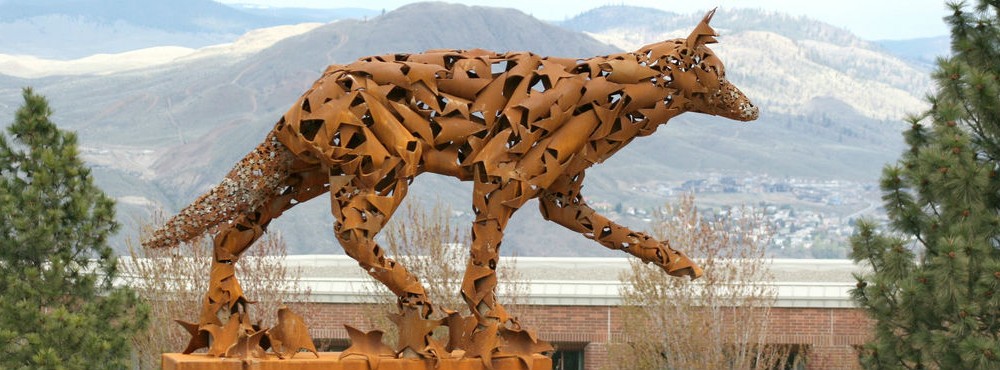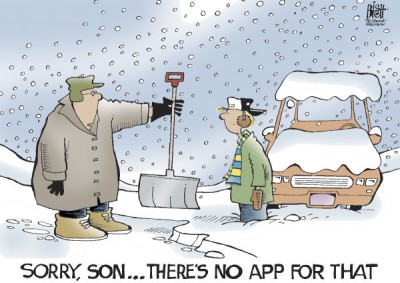Coyote Pedagogy is a term sometimes used to describe King’s writing strategies (Margery Fee and Jane Flick). Discuss your understanding of the role of Coyote in the novel.
Coyote is the quintessential trickster in the Native American oraliture. Yet, on top of stirring up trouble and testing moral precepts, Coyote also has “attributes that are unique from those of the European fool” (Lesson 3.2). Former Simpc Indian Band chief and university administrator has this to say about an a Coyote sculpture on Thompson Rivers University campus: “With the coyote we wanted something very symbolic to Interior Salish people. The coyote is a transforming creature that has significance to all Interior Salish people – transforming people in so many ways from what we know today.” Coyote is not only a playful shape-shifter and trickster, but also a creator and teacher. In Green Grass, Running Water, King’s portrays Coyote in a new light that nonetheless continues to trick and transform readers.
Upon my first reading of the novel, I was surprised and disorientated to find Coyote popping up in all over the place: dancing in the rain in a street corner in Blossom, arguing with ‘I says’, peeping into Fort Marion. He jumps fluidly between all three narrative threads, between the ‘real’ and the ‘fictive.’ I think King does this not only to remind readers of Coyote’s mythical character, but also to introduce a worldview in which the supernatural bleeds into the tangible all the time. Coyote’s historical permeability speaks to his nature as a shape-shifter: he is unconfinable and indefinable. It’s interesting to note however, that although he participates in both worlds just like the four Indians, ‘real’ human characters such as Lionel, Eli, and Alberta do not seem to notice his interjections.
The four Indians do, however, they help solidify Coyote’s identity as the traditional trickster. It’s hinted that he was the one who impregnated Alberta and the virgin Mary, and caused the Great Flood:
The last time you fooled around like this, said Robinson Crusoe, the world got very wet.
I didn’t do anything, says Coyote. I just sang a little […]
But I was helpful too, says Coyote. That woman who wanted a baby. Now that was helpful […]
Helpful! Said Robinson Crusoe. You remember the last time you did that?
“We haven’t straightened out that mess yet,” said Hawkeye
Hee-hee, says Coyote. Hee-hee. (King 416)
Coyote is an important character through which King accomplishes what James Cox terms acts of “narrative decolonization” (All This Water Imagery). Weaving in Native American characters like Coyote, King revises Western origin stories, and offering alternative explanations which undermine the metanarratives of the dominant discourse. In the novel, Noah’s Flood and the Immaculate Conception are just products of a canine’s well-intended mishaps, not acts of divine wrath or mercy. In this role, Coyote infiltrates, upends, and transforms the European American narratives which have been most central to the tenets of colonialism.
However, King’s Coyote is far from omnipotent or omniscient even if omnipresent. As the “master narrators” of the story, ‘I Says’ and Coyote keep up a friendly banter which nonetheless makes it clear that ‘I Says’ is teacher and Coyote is student.
Coyote functions as an extension of and a stand-in for the reader, modeling reader response. Often stumped, he turns to ‘I Says’ for help:
“Is this a puzzle?” says Coyote. “Are there any clues?” (100)
“I can see that”… “But I don’t get it,” says Coyote. (419)
Like him, the audience has access to all three narrative threads, and similarly, they have limited omniscience. Coyote is constantly corrected and told that he is “wrong again” (349). Like Coyote, we often have to readjust our values and expectations as we encounter the new and often jarring perspectives or worldviews presented in Green Grass, Running Water.
The badinage between ‘I says’ and ‘Coyote’ also reflects the organic spontaneity of oral storytelling. By making this relationship a narrative thread, King highlights and privileges the dynamics between storyteller and listener. Coyote often asks outrageous questions like whether Coyotes are Indians or not. Like him, the reader may make side comments or non sequiturs that are ‘ignored’ by the characters of the story. Neither can the audience control the trajectory of the narrative: “Coyote’s,” ‘I says’ tells him, “don’t get a turn” (327). When Coyote finally gets a turn to tell his tale, it turns out to be a reiteration of the beginning of the novel—he can only repeat what the authorial narrator has put in his mouth.
Nevertheless, Coyote remains full of curiosity and indefatigable enthusiasm. Like him, readers are encouraged to remain thoroughly engaged with the story. What Coyote teaches us, then, is precisely to be teachable, to be okay, as Professor Paterson says, when we do “not know” (Lesson 3.2). As Teacher, Transformer, and Trickster all in one, Coyote embodies the ignorant reader while retaining his Native roots. King’s Coyote Pedagogy is not only an effective way to pattern reader response and implicate the reader as a character in the novel, it also re-enacts the dynamic relationship between orator and listener, showing how both can contribute and participate in the tale, how both play the role of narrator and character.
—————————————————————————————————————–
Flick, Jane. “Reading Notes for Thomas King’s Green Grass Running Water.” Canadian Literature 161-162. (1999). Web. March 21, 2016
James Cox. “All This Water Imagery Must Mean Something.” Canadian Literature 161-162 (1999). Web. March 21, 2016
King, Thomas. Green Grass Running Water. Toronto: Harper Collins, 1993. Print.
Paterson, Erika. “Lesson 3.2.” ENGL 470A: Indigenous Lit. Web. 21 Mar. 2016.
Ramsey, Jarold. “Coyote (legend).” Oregon Encyclopedia. Web. 21 Mar. 2016.

